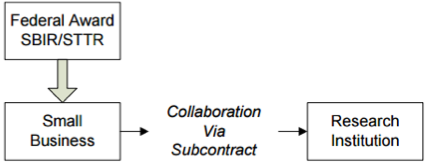In SBIR/STTR awards, federal funds are awarded to small businesses, which may collaborate with research institutions such as MIT on the award. If the PI has a significant financial interest (SFI) in the small business, it may pose a real or perceived conflict of interest (COI), and affect their participation in different phases of the award.

Phase I SBIR/STTR Awards and COI
- Every Investigator needs to file a disclosure (e.g. be named as key people on the proposal). An Investigator is anyone responsible for the design, conduct or reporting of the research.
- If the company is the MIT investigator’s Related Entity, MIT can only accept funding for the Phase I award. We cannot be involved in later phases with a Related Entity.
- Department must be willing to manage the oversight of any potential conflict of interest (COI).
- MIT PI cannot also be the PI on the company's proposal. It needs to be a full time employee of the company.
- Company personnel cannot be appointed at MIT.
- The SFI and relationships need to be disclosed in the proposal to the sponsor.
Phase II SBIR/STTR Awards and COI
SBIR/STTR Phase II awards are allowed only if the company is not a Related Entity of the MIT investigator. If the company is the MIT investigator’s Related Entity:
- Faculty often opt to create new relations with other researchers at other institutions so that the work can continue there.
- Faculty may request an exemption (Touchstone required) to COI policy.
Additional Information on SBIR/STTR Awards
Award Type |
Purpose |
Eligible Applicants |
|---|---|---|
SBIR/STTR Phase I |
Initiate research and development for new potential technology; establish technical merit, feasibility, and commercial potential of proposed R&D efforts to determine whether the awardee’s research merits Phase II funding. |
Small business concerns |
SBIR/STTR Phase II |
Continue R&D initiated in Phase I by testing the functional viability of the prototype according to scientific methods and potential for commercial development. |
Recipients of an SBIR/STTR Phase I award who demonstrate the scientific and technical merit and commercial potential of the project proposed in Phase II. |
SBIR Direct to Phase II |
Provide research and development funding for US small businesses that have already built a technology prototype and tested its feasibility. Not available for STTR program. For NIH SBIR proposals only. |
Non-recipients of an SBIR Phase I award who have completed Phase I-type research through other funding sources. Not available to STTR program. |
SBIR/STTR Phase IIB |
Supplemental award for Phase II awardees whose projects require extraordinary time and effort (e.g. FDA approval). |
Recipients of SBIR/STTR Phase II award |
SBIR/STTR Fast Track |
Mechanism for submitting a Phase I and Phase II award as one application to minimize potential funding gaps between Phase I and Phase II |
Small business concerns |
PFI-AIR-TT |
Award for NSF awardees with a research result that has commercial potential or graduates of NSF-funded I-Corps program. |
See your RAS Contract Administrator for more information |
SBIR/STTR Phase III |
Phase III work is typically oriented towards commercialization of SBIR/STTR research or technology. Phase III work may be for products, production, services, research and development, or any such combination. The following activities are examples of types Phase III work:
|
Recipients of SBIR/STTR Phase I and Phase II agreements that could be commercialized, extended, and/or logically concluded by further efforts. Phase III may also follow-on non-SBIR/STTR funded contracts with components of granting agency. |
Updated July 2, 2025
